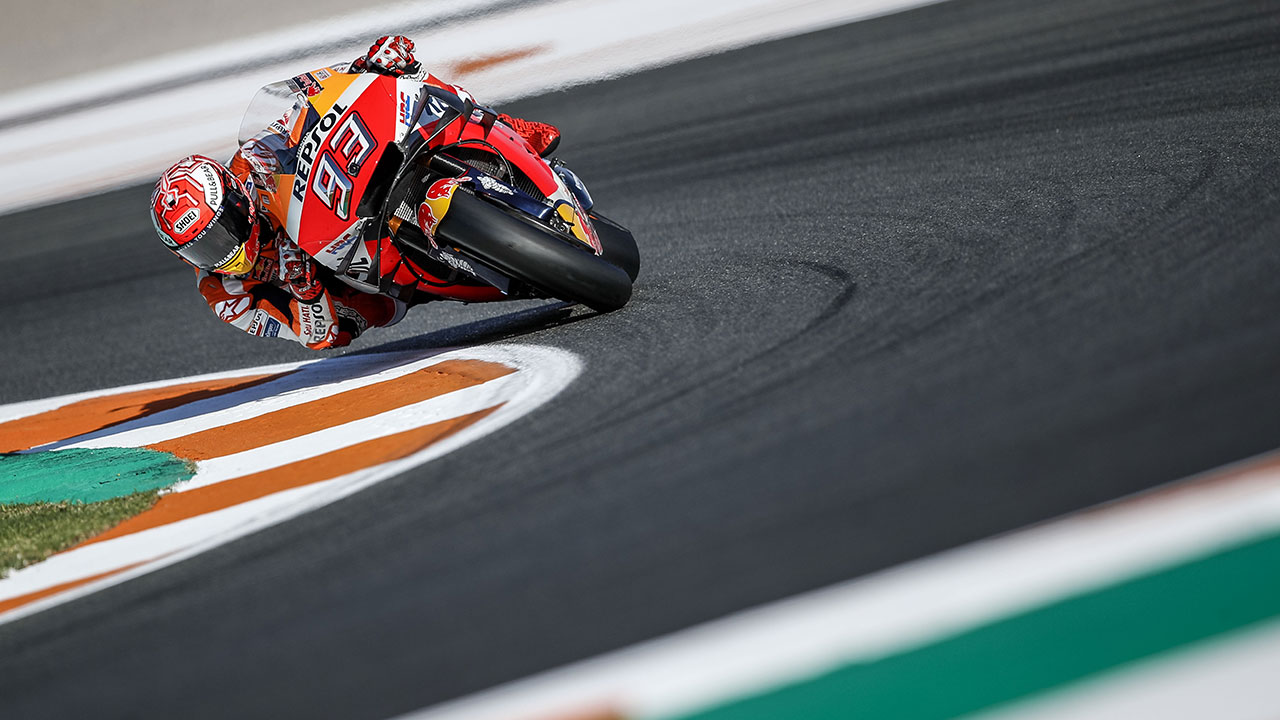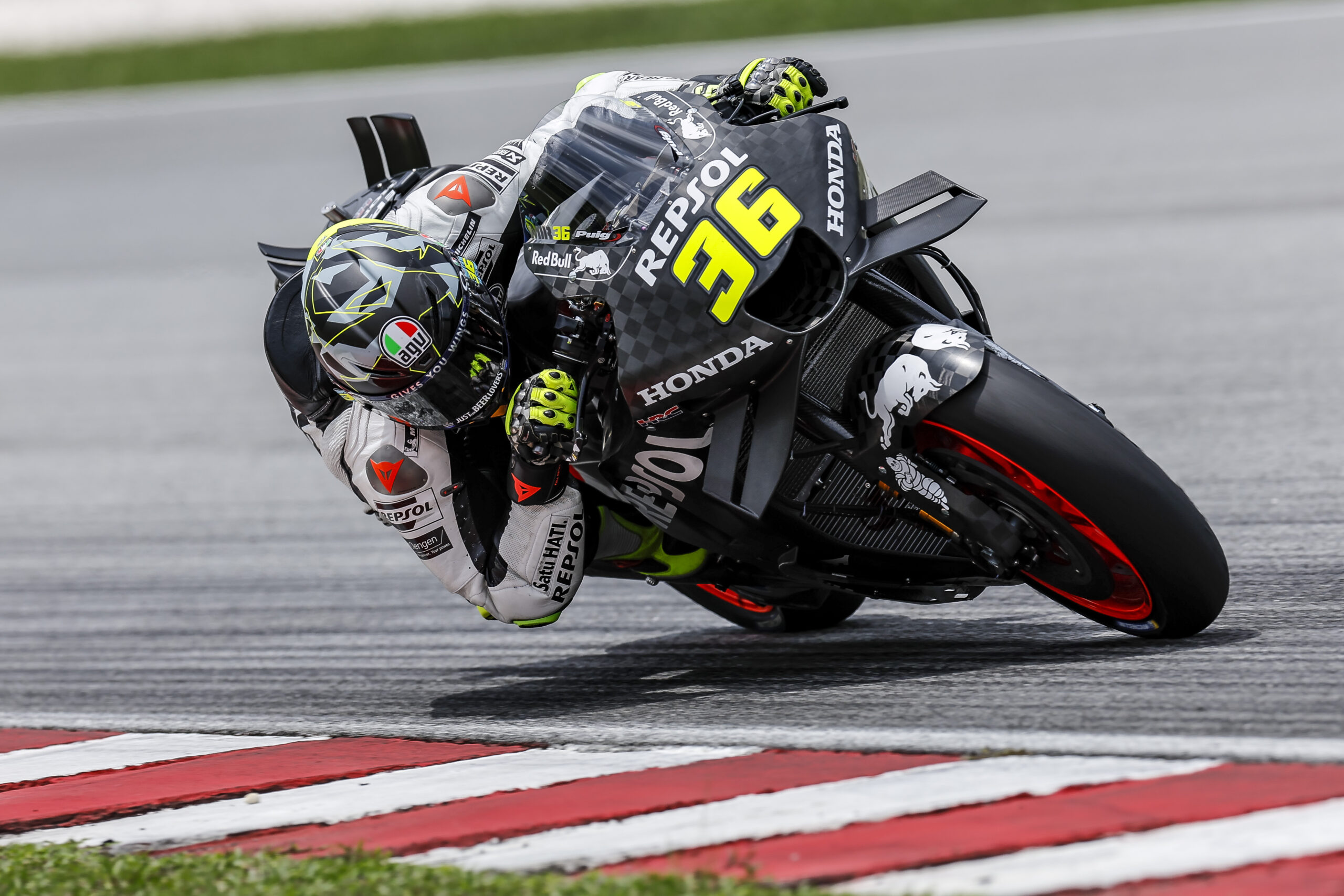1. Making the bike skid:
In MotoGP bikes, riders have a traction control programme in the ECU, which prevents the back wheel from skidding. But when it comes to riding fast, the riders need the bike to skid just the right amount. There are those who prefer more or less skidding, but the key is knowing how to master it in order to turn the bike.
As the rider skids the rear wheel, the bike changes its trajectory and takes the turn in a much faster way, thus being in a better position to accelerate as quickly as possible upon exiting the turn.
Additionally, even though it may seem strange, the tyres reach their maximum level of grip when they skid slightly on the asphalt.
Finding the adequate balance is difficult, and can be achieved with practice and experience. It’s key to evaluate the state of the tyres and the track correctly to know how to moderate the applicable traction control in each moment.


2. Body position:
During accelerations, braking, turning, or riding at a high speed, the body position is crucial. Riders learn how to adjust on their bikes and, above all, to take advantage of the movements and power generated by them to adapt the position of their body.
One of the greatest challenges when riding a MotoGP bike is achieving the least possible aerodynamic resistance. Regarding this objective, engineers work on the bike’s aerodynamics to allow it to cut through the air with the least amount of effort, but if the rider does not adopt the appropriate position, both turbulence and the aerodynamic deceleration generated will entail a loss of speed. It is very important to pay special attention to the position of the rider on the bike, so that they can be as low as possible behind the windscreen to achieve, at the same time, the greatest ease when moving in any situation.
In turns, it is necessary to take your body off the bike to help get the best lap, but when exiting, we can see how the MotoGP riders lift the machine while they hang off. With this action, they are gaining traction in the exit from the turns while maintaining the turn and a low centre of gravity to help pass each turn more quickly.
The position of the feet is extremely important to manage leverage, which allows you to grip the bike better when hanging off on turns.


3. Braking:
The brakes of a MotoGP bike are their most powerful element. The energy they are able to generate exceeds the grip of the tyres and gravity, making a sudden brake block the wheels or do a stoppie, if you don’t dose the pressure on the handle and the pedal well.
In MotoGP, you can see riders using the front handle with one or more fingers. In Marc Márquez’s case, he only uses his index finger. The way of using these elements is more of a preference for each rider than a technique. The rear brake, in addition to being used with the right foot pedal, can be used via a left-hand thumb handle, which is an option some riders prefer.
The combination of both brakes at the right amount is what allows the bike to stop in the shortest possible distance without losing control. But you must brake at the right moment. For this, riders use reference points like signs or commission points. In addition to these types of references, it is also necessary to evaluate the state of the track, tyres, and motorcycle in


In addition to the front and rear discs, the third mechanical element that plays a role in braking is the engine break. When the rider releases the gas pedal, for a skidding effect, it becomes a braking action that could destabilise the bike. For this, the ECU has a specific programme with various maps for the rider to be able to regulate the amount of engine brake they desire.
In general, the braking of the bike is performed by using 70% of the front brake, dividing the remaining 30% between the rear and engine brake. The key lies in this delicate balance, although that alone sometimes isn’t enough to stop the bike as quickly as is needed for the World Championship events. To brake a little extra, riders use other techniques.
4. Using your body as a brake
The sudden brakes in MotoGP bikes are close to 2g of deceleration. This power does not come only from the pull of the stop, which would cause the bike to go into an uncontrolled stoppie, but is due to the combination of the bike and the rider’s body resistance.
You can see how, during races, riders lift their bodies when braking. This way, the aerodynamic resistance helps with crucial extra braking power, while generating a descending pull in the rear train, preventing it from rising.


The effect is the opposite of what the riders want when they lower themselves on their bikes to reach maximum aerodynamic efficiency.
Additionally, the aerodynamic affect generated by the rider helps to compensate the compression of their arms due to the deceleration helping to take on the brakes with less effort.
It’s easy to have an idea of how this technique works. If you lower yourself onto the bike all the way at a certain speed, and then raise your body, you will notice the effect of the wind reducing your speed. Additionally, although it’s not recommended, the majority of us have experienced that feeling of deceleration when placing your hand out of the car window against the wind.
5. Dangling your leg while braking::
This manoeuvre, which MotoGP riders use when braking, is performed for various reasons.
We have already discussed how riders use their body to decelerate, but if they also let their leg dangle, they will increase the aerodynamic braking effect even more and reduce the effort. It may seem like little surface, but in MotoGP, every detail counts to gain milliseconds on the timer.
Additionally, upon dangling your leg, the bike’s centre of gravity is lowered slightly, achieving greater stability when braking. Since, in MotoGP, the legs are usually elevated, by lowering and dangling one, a mass displacement to the lower and rear part of the bike occurs.


Dangling your leg also produces a lever effect with the rest of the body, helping you position yourself better. This technique barely has negative points; it’s possible that if another rider gets close, they could come into contact with your leg and fall or get hurt. Additionally, lowering your foot a lot can entail greater friction with the asphalt and greater wear in the soles of your boots, although the manufacturers already foresee these types of circumstances and the boots usually come with special reinforcements.
Mastering these riding techniques requires years of work on the track, the ability to understand what is going on under your tyres, and how to manage your body while you ride. To compete in MotoGP, you need to master these and other techniques. The experience acquired after every lap and event will help you to find the way to be faster every time.


 Join Us
Join Us  Join Us
Join Us 